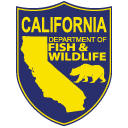 Black rockfish may be found north of Paradise Cove off southern California in a wide variety of habitats, including near the surface, on the bottom to depths of 1,200 ft., near rocky reefs, and in open water over deep banks or drop-offs. They frequently form loose schools 10 to 20 ft. above shallow (to 120 ft.) rocky reefs, in kelp beds, or in mid-water over deeper reefs (to 240 ft.), but individuals may also be found resting on rocky bottom.
Black rockfish may be found north of Paradise Cove off southern California in a wide variety of habitats, including near the surface, on the bottom to depths of 1,200 ft., near rocky reefs, and in open water over deep banks or drop-offs. They frequently form loose schools 10 to 20 ft. above shallow (to 120 ft.) rocky reefs, in kelp beds, or in mid-water over deeper reefs (to 240 ft.), but individuals may also be found resting on rocky bottom.
Distinguishing Characteristics
Brown to bluish-black on the back, paler on the sides, dirty white below. Continuous lighter band along lateral line. Body oval or egg-shaped; head with steep, almost straight upper profile; large mouth, lower jaw slightly projected. Black spots on the dorsal fin; anal fin rounded; upper jaw extends to rear of eye.
Life History & Other Notes
Black rockfish feed on squid, crab eggs, and various fishes. Like all rockfishes, fertilization and development of the embryos takes place within the body of the female. When development of the embryos is complete, the female releases the eggs. Exposure to sea water signals the embryos that it is time to break free of their egg cases.
These fish are commonly caught from commercial passenger fishing vessels, and incidentally when trolling for salmon. Rig a hook with almost any kind of cut fish bait. Mussel, clam, crab, shrimp, and squid strips work almost equally as well, as do some kinds of wet flies and other artificial lures.
Black Rockfish Quick Facts:
Scientific Name: Sebastes melanops
Other Common Names: black snapper, black bass
Range & Habitat: Statewide in a variety of habitats; uncommon south of Pt. Conception
Length & Weight: to 27+ in. and 10+ lb.
Life Span: to 50 years
Diet & Suggested Bait/Lures: Feeds on squid, crab eggs, fishes; try cut fish, mussel, clam, crab, shrimp, or squid strips for bait. Some artificial lures including wet flies work as well.
Excerpt from the California Finfish and Shellfish Identification Book. Single copies of the book are available to California residents free of charge by emailing a request to publications@wildlife.ca.gov.

